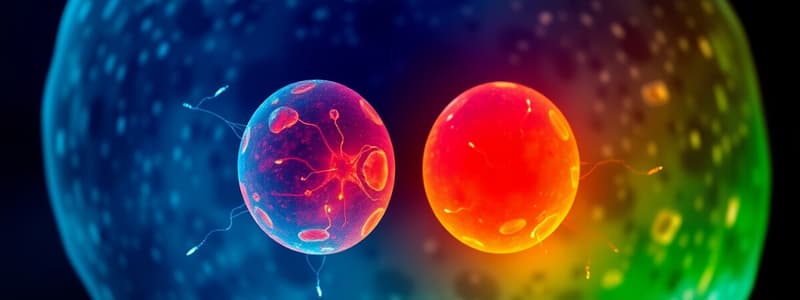Podcast
Questions and Answers
What is the primary outcome of Meiosis II?
What is the primary outcome of Meiosis II?
- Two genetically diverse diploid cells
- One haploid cell and one diploid cell
- Four genetically diverse haploid cells (correct)
- Two genetically identical diploid cells
Which phase of the cell cycle is primarily focused on DNA replication?
Which phase of the cell cycle is primarily focused on DNA replication?
- M phase
- S phase (correct)
- G1 phase
- G2 phase
What role do cyclins play in the regulation of the cell cycle?
What role do cyclins play in the regulation of the cell cycle?
- They are replicated during the S phase.
- They activate Cyclin-dependent Kinases (CDKs). (correct)
- They provide structural support to chromosomes.
- They initiate cytokinesis.
What is a key difference between Meiosis and Mitosis?
What is a key difference between Meiosis and Mitosis?
What is assessed at the G1 checkpoint of the cell cycle?
What is assessed at the G1 checkpoint of the cell cycle?
What is the primary purpose of mitosis in organisms?
What is the primary purpose of mitosis in organisms?
During which phase of meiosis does crossing over occur?
During which phase of meiosis does crossing over occur?
Which statement accurately describes telophase in mitosis?
Which statement accurately describes telophase in mitosis?
How many daughter cells are produced at the end of meiosis?
How many daughter cells are produced at the end of meiosis?
What occurs during anaphase I of meiosis?
What occurs during anaphase I of meiosis?
Which of the following best describes cytokinesis in plant cells?
Which of the following best describes cytokinesis in plant cells?
What is the main difference between mitosis and meiosis regarding chromosome number in daughter cells?
What is the main difference between mitosis and meiosis regarding chromosome number in daughter cells?
Which phase follows metaphase I in meiosis?
Which phase follows metaphase I in meiosis?
El ______ es un disolvente común utilizado en productos de limpieza y cosméticos.
El ______ es un disolvente común utilizado en productos de limpieza y cosméticos.
El ______ es un ácido que se utiliza en la producción de vinagre.
El ______ es un ácido que se utiliza en la producción de vinagre.
El ______ es un gas tóxico que se utiliza en la fabricación de plásticos y pesticidas.
El ______ es un gas tóxico que se utiliza en la fabricación de plásticos y pesticidas.
El ______ es una sustancia utilizada en la industria de alimentos como conservante.
El ______ es una sustancia utilizada en la industria de alimentos como conservante.
El ______ es un gas incoloro y altamente inflamable compuesto por carbono e hidrógeno.
El ______ es un gas incoloro y altamente inflamable compuesto por carbono e hidrógeno.
El ______ es un líquido inflamable que se utiliza como disolvente en la industria.
El ______ es un líquido inflamable que se utiliza como disolvente en la industria.
El ______ es un ácido utilizado en la producción de fertilizantes y como conservante en alimentos.
El ______ es un ácido utilizado en la producción de fertilizantes y como conservante en alimentos.
El ______ es un gas fogoso empleado en la fabricación de productos químicos.
El ______ es un gas fogoso empleado en la fabricación de productos químicos.
El ______ es un compuesto que se utiliza como conservante en alimentos y productos farmacéuticos.
El ______ es un compuesto que se utiliza como conservante en alimentos y productos farmacéuticos.
El ______ es un gas colorless que se produce principalmente de la combustión incompleta de combustibles fósiles.
El ______ es un gas colorless que se produce principalmente de la combustión incompleta de combustibles fósiles.
Flashcards are hidden until you start studying
Study Notes
Cell Division
Meiosis
- Definition: Type of cell division producing gametes (sex cells).
- Phases:
- Meiosis I:
- Homologous chromosomes separate.
- Stages: Prophase I, Metaphase I, Anaphase I, Telophase I.
- Result: Two haploid cells.
- Meiosis II:
- Sister chromatids separate.
- Stages: Prophase II, Metaphase II, Anaphase II, Telophase II.
- Result: Four genetically diverse haploid cells.
- Meiosis I:
- Significance:
- Introduces genetic variation through crossing over and independent assortment.
- Essential for sexual reproduction.
Mitosis
- Definition: Process of somatic cell division producing two genetically identical daughter cells.
- Phases:
- Prophase: Chromatin condenses into chromosomes; nuclear envelope dissolves.
- Metaphase: Chromosomes align at the cell's equator.
- Anaphase: Sister chromatids are pulled apart to opposite poles.
- Telophase: Nuclear envelopes reform; chromosomes de-condense.
- Cytokinesis: Cytoplasm divides, resulting in two separate cells.
- Significance:
- Facilitates growth and repair of tissues.
- Ensures genetic consistency across cells.
Cell Cycle Regulation
-
Phases of the Cell Cycle:
- Interphase: Preparatory phase (G1, S, G2).
- G1: Cell growth.
- S: DNA replication.
- G2: Preparation for mitosis.
- M Phase: Mitosis and Cytokinesis.
- Interphase: Preparatory phase (G1, S, G2).
-
Regulatory Mechanisms:
- Cyclins and Cyclin-dependent Kinases (CDKs): Drive the progression through the cell cycle.
- Specific cyclins are produced and degraded at different stages.
- Checkpoints:
- G1 Checkpoint: assesses cell size, DNA integrity.
- G2 Checkpoint: checks DNA replication completeness.
- M Checkpoint: ensures all chromosomes are attached to the spindle before mitosis.
- Cyclins and Cyclin-dependent Kinases (CDKs): Drive the progression through the cell cycle.
-
Significance:
- Precise regulation prevents uncontrolled cell division (cancer).
- Maintains genomic integrity and cell function.
Meiosis
- Produces gametes (sex cells)
- Involves two rounds of division: Meiosis I & Meiosis II
- Meiosis I: Separates homologous chromosomes, resulting in two haploid cells
- Stages: Prophase I, Metaphase I, Anaphase I, Telophase I
- Meiosis II: Separates sister chromatids, resulting in four genetically diverse haploid cells
- Stages: Prophase II, Metaphase II, Anaphase II, Telophase II
- Meiosis I: Separates homologous chromosomes, resulting in two haploid cells
- Introduces genetic variation through crossing over and independent assortment
- Essential for sexual reproduction
Mitosis
- Process of somatic cell division, producing two genetically identical daughter cells
- Involves four distinct phases:
- Prophase: Chromatin condenses into chromosomes, and the nuclear envelope dissolves
- Metaphase: Chromosomes align at the cell's equator
- Anaphase: Sister chromatids are pulled apart to opposite poles
- Telophase: Nuclear envelopes reform, and chromosomes decondense
- Cytokinesis: Cytoplasm divides, resulting in two separate cells
- Facilitates growth and repair of tissues
- Ensures genetic consistency across cells
Cell Cycle Regulation
- Consists of two main phases: Interphase and M Phase
- Interphase: Preparatory phase, including G1, S, and G2
- G1: Cell growth
- S: DNA replication
- G2: Preparation for mitosis
- M Phase: Mitosis and Cytokinesis
- Interphase: Preparatory phase, including G1, S, and G2
- Regulated by cyclins and cyclin-dependent kinases (CDKs)
- Specific cyclins are produced and degraded at different stages, driving the cell cycle progression
- Checkpoints ensure proper cell cycle control:
- G1 Checkpoint: assesses cell size and DNA integrity
- G2 Checkpoint: checks DNA replication completeness
- M Checkpoint: ensures all chromosomes are attached to the spindle before mitosis
- Precise regulation prevents uncontrolled cell division (cancer)
- Maintains genomic integrity and cell function
### Common Chemicals & Properties
- Acetone (CH3COCH3) is a flammable liquid (FL) and is used as a solvent.
- Acetic acid (CH3COOH) is a colorless liquid with a pungent smell.
- Ammonia (NH3) is an aggressive material (AM) and is used in fertilizer production.
- Ammonium hydroxide (NH4OH) is commonly used in cleaning products.
- Ammonium sulfate ((NH4)2SO4) is used as a fertilizer.
- Carbon dioxide (CO2) is a colorless gas.
- Carbon monoxide (CO) is a toxic gas (TG) known to cause carbon monoxide poisoning.
- Carbonic acid (H2CO3) is a weak acid formed from the dissolution of carbon dioxide in water.
- Nitric acid (HNO3) is a strong acid and an aggressive material (AM).
- Barium alkali (hydroxide) (Ba(OH)2) is an aggressive material (AM).
- Petrol (C6H14...C10H22) is a flammable liquid (FL).
- Borax (Na2B4O7 · 10H2O) is a commonly used cleaning agent.
- Boric acid (H3BO3) is a weak acid and is often used as an antiseptic.
- Butane (C4H10) is a flammable gas (FG).
- Chlorine (Cl2) is a toxic gas (TG) commonly used for disinfecting water.
- Hydrochloric acid (HCl) is a very strong acid and an aggressive material (AM).
- Ethane (C2H6) is a flammable gas (FG).
- Ether (C2H5OC2H5) is a flammable liquid (FL) and is generally used as a solvent.
- Ethyl alcohol (C2H5OH) is a flammable liquid (FL) and is widely consumed as an alcoholic beverage.
- Ortho-phosphoric acid (H3PO4) is a strong acid and an aggressive material (AM) used in fertilizer production.
- Phosgene (COCl2) is a toxic gas (TG) known to be very poisonous.
- Glycerol (C3H5(OH)3) is a colorless liquid used in the production of cosmetics and pharmaceuticals.
- Iodine (I2) is commonly used as a disinfectant and is a flammable liquid (FL).
- Calcium hydroxide (Ca(OH)2) also known as "slacked lime," is an aggressive material (AM).
- Calcium carbonate (CaCO3) is known as "chalk" or "limestone" and is used in building materials and cement.
- Calcium oxide (CaO) is called “burnt lime” and is an aggressive material (AM).
- Potassium dichromate (K2Cr2O7) is a highly toxic compound and is found in various industrial applications.
- Potassium carbonate (K2CO3) is also known as "potash" and is used in fertilizer production.
- Potassium permanganate (KMnO4) is a strong oxidizer and is used as an antiseptic and disinfectant.
- Potassium alkali (KOH) is an aggressive material (AM) and is used to make soap and detergents.
- Crystalsoda (Na2CO3 ·10H2O) is a common cleaning agent.
- Methane (CH4) is a flammable gas (FG) that is a primary component of natural gas.
- Sodium chloride (NaCl) or "white salt" is a commonly used seasoning.
- Sodium alkali (NaOH) is an aggressive material (AM) and is used to make soap and detergents.
- Sodium hydrocarbonate (NaHCO3) is also known as "baking soda" and is used in baking and various other applications.
- Propane (C3H8) is a flammable gas (FG) and is used as a fuel source.
- Sulfuric acid (H2SO4) is a very strong acid and an aggressive material (AM).
- Hydrosulfide (H2S) is a toxic gas (TG).
- Soda (Na2CO3) is used in the manufacturing of glass and is a base.
Flammable Liquids
- Acetone (CH3COCH3)
- Ethyl alcohol (C2H5OH )
- Ether (C2H5OC2H5)
- Glycerol (C3H5(OH)3 )
- Petrol (C6H14...C10H22)
- Potassium permanganate (KMnO4)
Aggressive Materials (AM)
- Acetic acid (CH3COOH)
- Barium alkali (hydroxide) (Ba(OH)2)
- Boric acid (H3BO3)
- Calcium hydroxide (slacked lime) (Ca(OH)2)
- Chlorine (Cl2)
- Hydrochloric acid ( HCl)
- Nitric acid (HNO3)
- Ortho-phosphoric acid (H3PO4)
- Potassium alkali (KOH)
- Sodium alkali (NaOH)
- Sulfuric acid (H2SO4)
Toxic Gases (TG)
- Carbon monoxide (CO)
- Chlorine (Cl2)
- Phosgene (COCl2)
- Hydrosulfide (H2S)
Flammable Gases (FG)
- Ammonia (NH3)
- Butane (C4H10)
- Ethane (C2H6)
- Methane (CH4)
- Propane (C3H8)
Other Important Points
- Crystalsoda is Sodium carbonate decahydrate (Na2CO3 ·10H2O)
- Sodium hydrocarbonate is backing soda (NaHCO3)
- Calcium carbonate is chalk or limestone (CaCO3)
- Calcium oxide is burnt lime (CaO)
- Potassium carbonate is potash (K2CO3)
- Sodium chloride is white salt (NaCl)
Studying That Suits You
Use AI to generate personalized quizzes and flashcards to suit your learning preferences.





